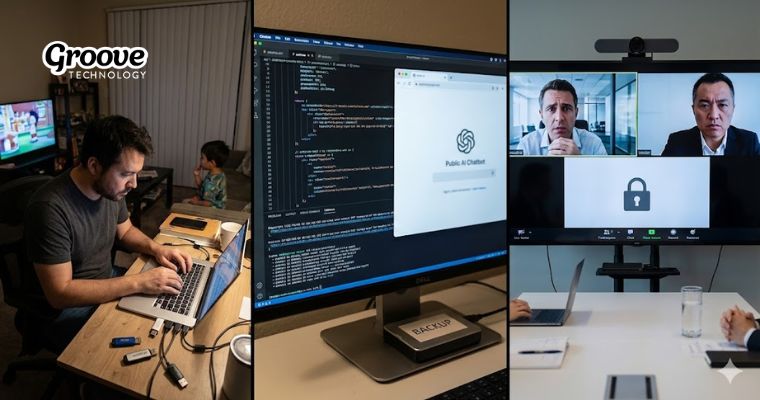7 Challenges Of Software Development Outsourcing And Smart Solutions To Fix
Software development outsourcing is more than simply hiring an external team to write code. True success requires not only technical expertise but also a deep understanding of business context, brand identity, and long-term goals. When vendors operate without this context, their decisions tend to be mechanical, resulting in generic solutions that fail to create real differentiation.
At the same time, pressure for speed often comes at the expense of software architecture. This is where “spaghetti code” emerges, systems that appear stable at first but are poorly structured, difficult to scale, and increasingly fragile over time. As a result, 50 – 70% outsourcing projects miss their original objectives despite significant investments in time and budget.
Beyond technical challenges, outsourcing also involves financial, operational, and security risks. Unclear requirements can lead to costly rework, cultural differences may create a “yes trap,” and opening systems to third parties increases the risk of data exposure. In this article, Groove Technology examines these core challenges and shares practical solutions to help businesses turn outsourcing risks into competitive advantages.

Poor Communication
This challenge is rarely about vocabulary; it is about the “context vacuum.” While in-house teams absorb information through office osmosis, outsourced teams only know exactly what is written in the ticket. They operate without the benefit of tone or body language, often interpreting instructions literally.
For instance, a vague request to “make it modern” might result in a generic template because the team lacks your specific brand history and high-context cues. If a requirement like encryption isn't explicitly documented, it generally won't be built.
Solution:
- The “Teach-Back” Method: Ask developers to paraphrase the task in their own words to verify they understand the intent, not just the vocabulary.
- Visual Over Verbal: Reduce ambiguity by replacing long text descriptions with annotated screenshots, diagrams, or screen recordings to explain requirements visually.
- Establish a “Safe” Feedback Loop: Explicitly state that identifying flaws in a plan is a valuable contribution, not an insult to the client.
- Clear Communication Channels: Standardize tools like Slack, Microsoft Teams, or Zoom to centralize discussions, ensuring questions are answered quickly rather than getting lost in email threads.
- Regular Progress Syncs: Schedule consistent meetings—such as daily stand-ups or weekly reviews, to maintain alignment, track updates, and address blockers immediately.

Quality Control
The most dangerous aspect of outsourcing is that functional software often hides structural rot. Outsourced teams may produce “spaghetti code”, which is messy and unstructured, that works superficially but fails under pressure when being incentivized by speed. This often results in a “Frankenstein” architecture where developers use conflicting libraries for similar tasks, causing crashes during integration.
Additionally, there is also a common syndrome where code tested in an isolated environment fails once deployed to a production server with real-world data constraints.
Solution
- Internal Code Reviews: Never allow vendors to merge their own work. A senior internal developer must review and approve every Pull Request (PR) to ensure standards.
- Technical Debt Quotas: Allocate 10–20% of every sprint specifically for refactoring code and fixing bugs to maintain long-term stability.
- Structured QA/QC Checklists: Establish a rigorous quality assurance process with clear checklists to ensure every feature meets specific functional standards before delivery.
- Comprehensive Test Coverage: Implement extensive automated testing suites to minimize manual errors and ensure that logic holds up across different scenarios.
- Periodic Quality Reporting: Require partners to provide regular test reports detailing bug counts, coverage metrics, and resolution speeds to ensure transparency.

Project Management
Outsourcing involves managing a complex ecosystem of multiple stakeholders, including clients, remote teams, and third-party vendors. Without structured project management, this complexity quickly results in missed deadlines, exceeded budgets, and unmet business goals.
The failure often stems from structural voids: the lack of a dedicated Project Manager to drive execution, undefined Key Performance Indicators (KPIs) to measure success, or the application of unsuitable management methodologies. Consequently, projects drift off course, creating a critical gap between the strategic plan and the actual delivery.
Solution
- Strict Agile Ceremonies: Enforce daily stand-ups and bi-weekly sprint planning to maintain constant visibility, regardless of time zone differences.
- Shared Dashboards: Mandate a single project management tool (like Jira or Asana) that you control, preventing vendors from tracking progress on private, invisible sheets.
- Define “Done” Explicitly: Create a “Definition of Done” (DoD) checklist, ensuring tasks are only marked complete after testing and QA approval, not just code completion.

Cost Management
Outsourcing is often chosen for cost savings, yet hidden expenses can easily make it more costly than local hiring. The primary driver is the “Cost of Ambiguity”: if your requirements are only 95% clear, the missing 5% becomes expensive “Change Requests” (e.g., adding an unspecified offline mode).
Additionally, companies often overlook the “Management Overhead Tax,” where internal senior staff must spend valuable hours reviewing code and managing the vendor. Finally, communication failures lead to the cost of re-work, forcing you to pay twice: once to build the wrong feature, and again to fix it.
Solution:
- Detailed Requirements Phase: Invest heavily in a granular “Scope of Work” (SOW) upfront; the more specific the requirements, the fewer billable surprises occur later.
- Hybrid Pricing Models: Use a “Fixed Price” model for the MVP to control the initial budget, then switch to “Time & Materials” for flexibility in future iterations.
- Weekly Budget Burn Reports: Mandate weekly reports tracking hours used versus the budget to spot and address overspending immediately.

Data Security
When outsourcing software development, you are essentially opening your firewall to strangers, creating inherent vulnerabilities. According to a report by the Ponemon Institute, approximately 63% of data breaches are directly or indirectly related to third parties. Businesses often lack visibility into endpoint security, whether a developer's laptop is shared, lacks antivirus software, or is compromised, which puts your source code at risk.
Furthermore, developers might copy customer databases to local machines or paste sensitive code into public AI tools for debugging, causing irreversible data leakage. In extreme cases, the “Code Hostage” risk arises, where a vendor with administrative control locks you out of your servers or withholds source code during payment disputes.
A prime example is the 2013 data breach at the retail giant Target. Hackers accessed Target's systems through login credentials stolen from an outsourced vendor. As a result, information on 40 million credit cards was stolen, causing hundreds of millions of dollars in losses.
Solution
- Principle of Least Privilege: Grant access only to the specific repositories and databases required for the task, never the entire system.
- Dev/Prod Separation: Never allow access to the live “Production” database; enforce work in a “Staging” environment using dummy data.
- VDI (Virtual Desktop Infrastructure): Requires developers to work on secure, remote virtual machines you control, ensuring code never touches their personal devices.
- Pre-Engagement Security Audits: Conduct a rigorous security audit of the partner before signing any agreement to ensure their internal protocols meet your safety standards.
- Strict Non-Disclosure Agreements: Sign comprehensive NDAs and legal contracts that explicitly define data ownership and penalties for confidentiality breaches.
- Mandatory VPN Usage: Require the use of a Virtual Private Network (VPN) for all remote connections to encrypt data transmission and mask network entry points.

Cultural Alignment
This challenge is rarely about language fluency but rather communication culture and intent. A practical example is the contrast between Western businesses, which often prioritize direct communication, and many East Asian countries that value “saving face.” This leads to development teams knowing about project problems but hesitating to warn clients early, causing small errors to accumulate into major disasters.
In many outsourcing hubs, deep-seated cultural hierarchies view challenging a client as disrespectful. This often leads to the “Yes” trap: when you ask, “Can this be done by Friday?”, a vendor may answer “Yes” out of respect, meaning “I will try my absolute hardest.” You, however, hear “Yes” as a guarantee. When the deadline is inevitably missed, you feel deceived, while they feel they honorably did their best to serve you.
Solution
- Ask Open-Ended Questions: Avoid “yes/no” constraints. Instead of asking “Can you finish this?”, ask “What challenges do you see in delivering this by Friday?” to force a safe explanation of risks.
- Psychological Safety: Explicitly reward honesty over compliance. Making it clear that admitting a deadline is impossible is a valuable contribution, not a failure.
- Designate a “Proxy” Product Owner: Assign a team lead on the vendor side who understands Western directness to act as a “translator” for cultural expectations.

Time Zone Differences
The real cost of time zones isn't the early morning meetings; it is the “24-Hour Resolution Cycle.” With an internal team, a clarification takes five minutes. With an offshore team, a question asked while you sleep pauses work until you wake up, by which point the developer is asleep. This cycle turns a simple query into a full day of lost productivity.
A study from the Journal of IT indicates that teams working across significantly different time zones tend to be 20-30% less productive than teams working within the same timeframe, unless there is a very strict handover process. For example, a developer missing a single API key might stop working entirely for 24 hours just waiting for that one piece of information. To combat this, you must write “blocker-proof” specifications, anticipating every possible question to prevent stalling.
Solution
- Establish “Golden Overlap Hours”: Mandate a strict 1–2 hour window where both teams are online effectively. Use this time solely for unblocking issues, not for general status updates.
- Write “Blocker-Proof” Tickets: Invest extra time creating detailed specifications with screenshots and “If/Then” scenarios, assuming you will not be available to answer questions.
- Empower Decision Making: Explicitly instruct the team: “If you are stuck and I am unavailable, make a decision and proceed.” It is better to fix a mistake later than to idle for eight hours.
- Follow-the-Sun Model: Leverage time zone differences to ensure continuous project development 24/7, allowing one team to pick up exactly where the other left off.
- Extended Interaction Windows: Establish a minimum of 2–4 hours of “overlap hours” each day so that both parties can meet and address urgent issues directly.

Successfully overcoming the challenges of software development outsourcing requires proactive strategies, not just technical skills. We have explored critical issues like communication barriers, quality control, and security risks, offering practical methods to turn these obstacles into competitive advantages for your business.
Groove Technology, an Australian firm founded in 2016 with operations in Vietnam, stands ready to be your strategic partner. Serving clients globally, we provide high-performance teams that ensure transparency, innovation, and quality, helping you achieve technical excellence and sustainable growth.
Related Articles:
- Top 10+ Largest Software Outsourcing Companies You Should Know in 2025
- Define Software Development Outsourcing Benefits for Growing Businesses
- How to Hire Software Developers Outsourcing for Cost-Effective Growth





